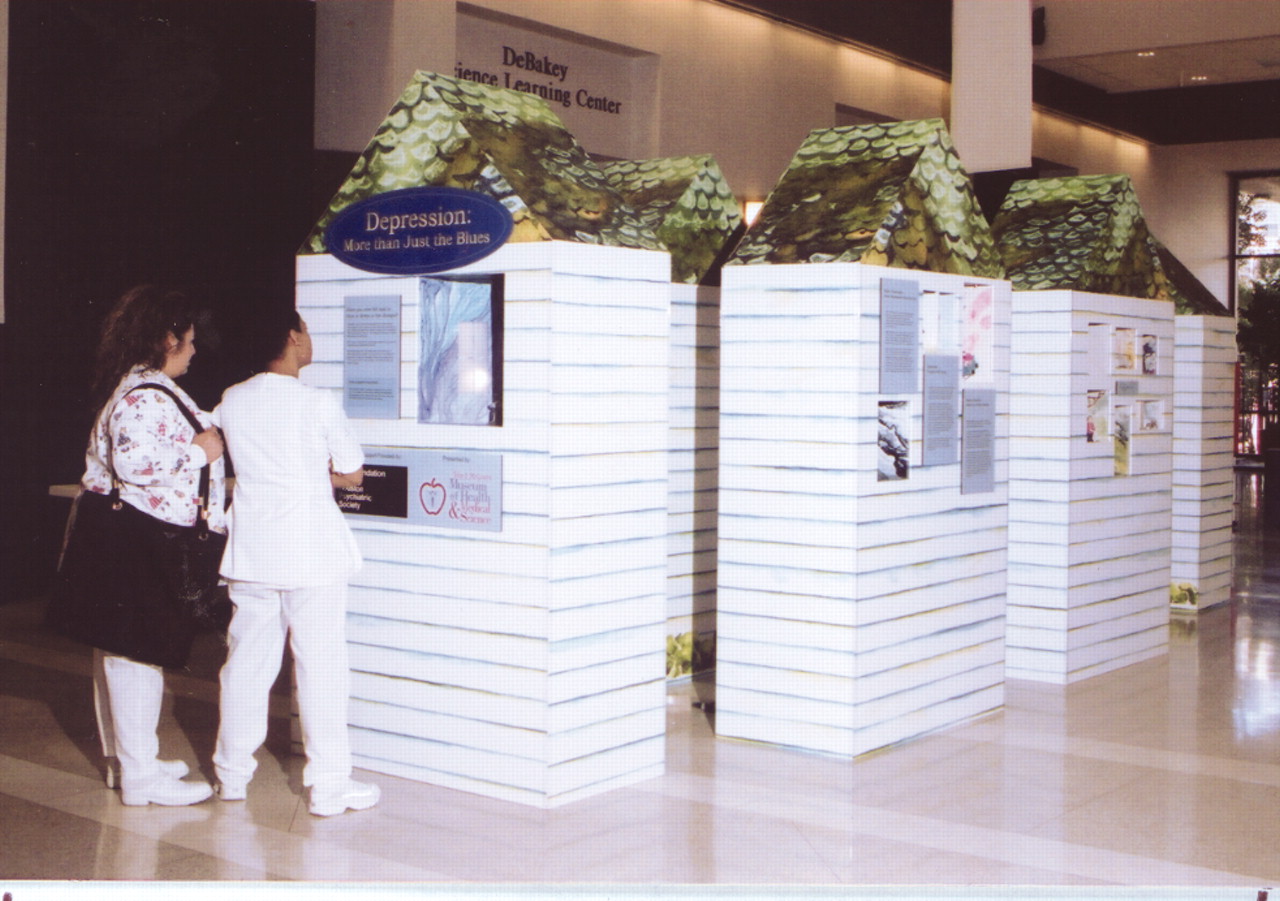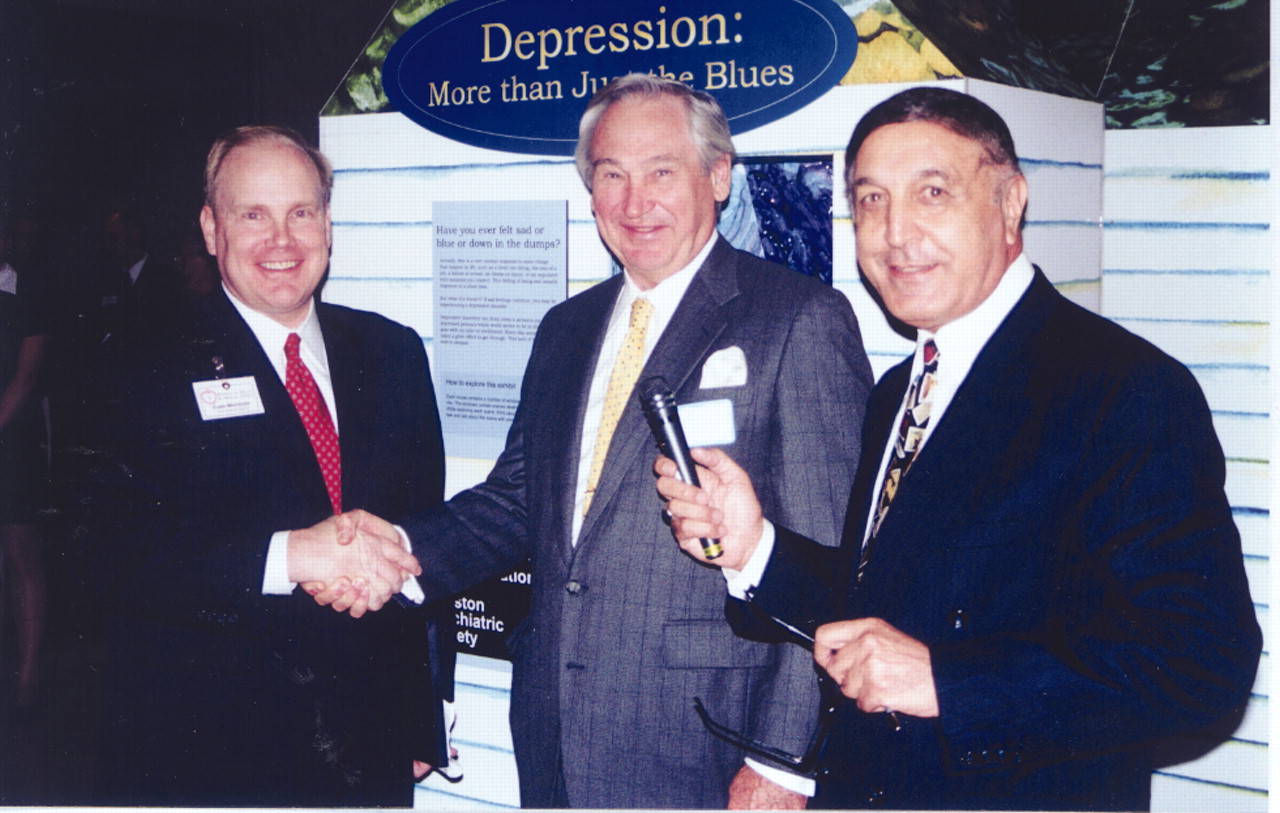It isn’t often that people can stroll through a museum and learn about neurotransmitters, psychotherapy, or antidepressants. But at the John P. McGovern Museum of Health and Medical Science in Houston, depression is on exhibit.
“Depression: More Than Just the Blues” is the newest addition to the museum’s array of medical exhibits and combines art with scientific research to convey information about depression to the American public. The exhibit opened to the public last October.
Information on depression is displayed on the walls and inside the windows of six miniature “houses” through paintings, sculptures, and text.
Each house represents a certain aspect of the brain-based disorder: the neurochemical basis of depression, depressive disorders, treatments, and suicide, for instance.
In the house depicting the different causes of depression, visitors can peer into its windows to see handcrafted dolls in a variety of contexts—a man sits alone in a bar to indicate the role that alcohol and substance abuse play. Chronic illness, which also contributes to depression, is depicted in another window by a woman who sits in a hospital bed hooked up to an IV line.
Visitors to the exhibit are also confronted by the stark numbers associated with the disease—340 million people worldwide are believed to be living with some form of depression, and 500,000 people each year are treated in U.S. emergency rooms for a suicide attempt.
The last house of the exhibit provides visitors with a number of resources from which they can learn more about depression or seek help themselves. Brochures from the National Institute of Mental Health and National Mental Health Association include local and toll-free numbers for crisis hotlines and support groups not only in Houston but throughout the United States.
Foundation Funds Exhibit
The exhibit is a gift from the Foundation of the Houston Psychiatric Society. Mohsen Mirabi, M.D., who was one of the founders of the foundation, was elected to its presidency in 2000.
Mirabi is a clinical associate professor in Baylor College of Medicine’s department of psychiatry and behavioral science and a past president of the Houston Psychiatric Society.
When he was elected president of the foundation, Mirabi made it his mission to establish a psychiatric exhibit at the medical museum, which happens to be a stone’s throw from the Texas Medical Center complex.
“We decided to establish an exhibit on depression since it affects such a wide range of people,” said Mirabi, who calls depression “the most treatable untreated illness.”
“Our goal in supporting the project is to increase awareness of the warning signs of depression and help people understand its causes and treatments,” said Mirabi at the exhibit’s opening ceremony. “We also want to encourage people to seek help.”
Mirabi told Psychiatric News he knows of eight freestanding medical museums in the United States and five medical exhibits that are part of larger museums, “yet none offers any exhibit exclusively pertaining to a disease entity among psychiatric illnesses.”
Long Tradition of Reaching Out
“More Than Just the Blues” is the most recent contribution of the Foundation of the Houston Psychiatric Society to the people of Houston.
The organization, founded by Mirabi and some of his fellow psychiatrists in the mid-1980s, is involved in educating the public about mental illness and assisting those in need.
When the Houston economy spiraled downward in 1986, for instance, the foundation formed a “Clinic Without Walls” in which Houston-area psychiatrists affiliated with the foundation provided free psychiatric services to the unemployed. “The unemployment rate in the city had reached 12.5 percent,” recalled Mirabi, “and 30 of us provided psychotherapy on an individual and group basis to those who needed our help.”
Other Initiatives
In 1987 the foundation developed the miniseries “Psychiatry: Helping and Healing,” which aired on the public television station in Houston that year and the next. In the series, Houston Psychiatric Society members discussed topics such as substance abuse, eating disorders, psychotic disorders, and sexual dysfunction. Additional psychiatrists staffed phone lines and provided referrals.
Five years later, in 1992, the foundation partnered with the Greater Houston Area chapter of the American Red Cross on its Persian Gulf Family Support Project to provide counseling for soldiers returning from the Gulf War.
As part of the exhibit, the Houston Psychiatric Society has been holding brown-bag lunch lectures each month that are free to the public. Discussions led by society members have focused on depression; women and mental health; mental health issues among children, adolescents, and geriatric populations; and other mental health crises.
After a visit and lecture this month by APA President Paul Appelbaum, M.D., Mirabi and the museum directors planned to take the exhibit on the road to educate people outside the greater Houston area about depression. Mirabi said the exhibit, which is designed for travel, will make its way to schools, community centers, hospitals across Texas and the nation and, it is hoped, one of APA’s annual meetings.
Stigma Reduction
In its home at the John P. McGovern Museum of Health and Medical Science, Mirabi said, the exhibit has received positive feedback. He noted that 10,000 young people visit the museum every month and that many walk into the museum with no prior knowledge about depression or mental illness.
“I believe this exhibit will make a tremendous impact on reducing the stigma associated with mental illness,” he said. ▪


